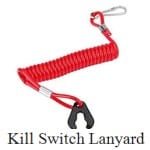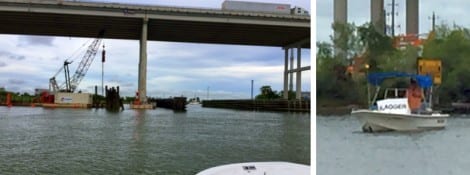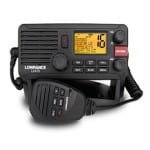 By Bob Currie, Vessel Examiner
By Bob Currie, Vessel Examiner
U. S. Coast Guard Auxiliary Station Galveston Flotilla
As an old airline pilot friend of mine likes to say, flying isn’t dangerous; it’s the taking off and landing where most problems occur. It’s like that with boats, too. Although you can certainly get run over on the high seas, the majority of problems occur at or near the dock. Another problem area is the narrow channel with heavy traffic. This column will deal with these problem areas.
The Station Galveston Flotilla of the US Coast Guard Auxiliary operates out of the USCG Station Galveston base on Galveston Island. They provide assistance to the Coast Guard by providing maritime observation patrols in Galveston Bay; by providing recreational boating vessel safety checks; and by working alongside Coast Guard members in maritime accident investigation, small boat training, watch standing, and procurement.
Using the Kill Switch
It’s now the law. If your boat came equipped from the manufacturer with an emergency kill switch, you must test it prior to departure and the kill switch lanyard must be attached to the operator.  It’s so simple to test it. Crank the engine, and then pull the lanyard until the clip comes off the kill switch. Perform this safety procedure each time before you use your boat. I also recommend having a spare lanyard aboard and letting your passengers know where it is and how to use it. If you only have one lanyard and you end up in the water with that lanyard attached to your wrist or vest, how are your passengers going to pick you back up?
It’s so simple to test it. Crank the engine, and then pull the lanyard until the clip comes off the kill switch. Perform this safety procedure each time before you use your boat. I also recommend having a spare lanyard aboard and letting your passengers know where it is and how to use it. If you only have one lanyard and you end up in the water with that lanyard attached to your wrist or vest, how are your passengers going to pick you back up?
Taking Off and Landing
Except when going out on patrol with the Coast Guard Auxiliary, I rarely go boating on weekends due to the extra traffic. Being retired, I have 5 days a week I can go out, so I leave the water on Saturdays and Sundays to those who only have the weekends. That said, I have been on two weekend patrols of the Clear Lake Creek Channel in the last month, including an evening/night patrol this past Saturday. Remember the scene from Jaws where dozens of boats of all sizes, mostly overloaded, were heading out to catch the big shark? It was kind of like that. Boats were moving in all directions in a crowded channel, so it was hard to leave the marina and enter the channel. It seems that there is always an impatient boater behind you who thinks he can jump out between two boats. It’s like a traffic jam on 610 Loop, but without marked lanes. This is when great care is needed. You need fore and aft lookouts, because there is danger behind you as well as in front of you.
Jumping up on plane before you are clear of the traffic jam puts both your boat and other boats in danger of collision. Before you come out on the throttle, make sure you are not being overtaken from behind by a faster moving boat. You need an “all clear” from your lookouts before accelerating. Before you do accelerate, be sure your boat is steered in the direction you want to move and your engine is trimmed down enough to accelerate smoothly rather than point the bow to the stars. Let your passengers know you are about to come out on the throttle by saying loudly “Coming up!” Once you are up on plane, pause your acceleration long enough to set the trim and reassess the boat traffic. Then you can go to your cruising speed. Before you came out on the throttle you made sure your passengers were evenly distributed and fully seated, right?
In the Holding Pattern
Surely you have been in a plane and had the captain announce that you would be going into a holding pattern to let traffic on the ground clear up. The captain would just fly in a great big circle at the height prescribed by the control tower. Sometimes you have to go into a holding pattern with your boat. You get back to the ramp and there are multiple boats waiting to be trailered or are being launched, or they are backing into or out of their slips, or trying to tie up to the dock. In any case, you have to find a spot that doesn’t put you in the way of boaters who are trying to launch or reach their trailer at the ramp. Just like your airline captain, you must go into a holding pattern. Unfortunately, there is no traffic controller to tell you where to make your circle. You have to use your own judgment and skills to find a place to hold. Here is where the knowledge of your boat’s handling characteristics is crucial.
Unless you are in a protected cove and there is no wind or current, you will be battling the elements of wind, tide, and current. In order to maintain a position in the water whenever there is wind and current, you will need to use your steering and throttle to stay in place. Sometimes it is enough to just work the throttle between forward, neutral, and reverse, but many times you will have to make slow circles. The twin engine boats have the advantage here. If you want to circle to the left, you put the left engine in reverse and the right engine in forward. The less throttle you use, the tighter the circle. You must use enough throttle to overcome the wind and current though. If you have a single prop, then your work is cut out for you. You will have to turn the steering wheel fully to the left, put the throttle in forward briefly, then turn the steering wheel fully to the right and reverse the engine. This will put you in a turn to the left. Pick a spot in the water that is not too close to another boat, and then make sure no one sneaks up on you.
There are other places where you may need to be able to hold your position. In parts of Galveston Bay you must boat within a marked channel in order to keep from grounding. If you boat in the Clear Lake area, you probably know that the Kemah Bridge is under construction, and one side of the channel beneath the bridge is closed. During this construction, traffic under the bridge is one direction only, and the direction swaps every half hour. There are flaggers and a traffic light to let you know which direction the boat traffic is moving at any time. If you are unlucky enough to come up to the bridge just as the light goes red, you will have to go into a holding position for 30 minutes. In heavy boat traffic like we had on Saturday, there was a lot of boat bumping going on. You not only had to hold position, you had to be able to move out of the way of a boater who had poor control of their boat. Good lookouts are crucial in a situation like this.

Vessel Traffic Control
I said there is no air traffic controller on the water, but that is not quite true. Vessel Traffic Control in Houston controls the movement of large vessels within the ship channel. You can listen to their directions to those large vessels by monitoring marine channels 5A, 11, and 12.  The Coast Guard makes frequent announcements regarding safe boating, and the Kemah Bridge channel restrictions are announced several times a day on marine channel 16. Anyone who boats in Galveston Bay should have a marine radio and monitor channel 16 closely for marine safety broadcasts.
The Coast Guard makes frequent announcements regarding safe boating, and the Kemah Bridge channel restrictions are announced several times a day on marine channel 16. Anyone who boats in Galveston Bay should have a marine radio and monitor channel 16 closely for marine safety broadcasts.
Summary
Extra caution should be taken at certain points of a boat trip. Those points include departing and arriving at the ramp or dock and when operating in a narrow channel when there is heavy boat traffic. You should have a great knowledge of your boat’s specific handling characteristics, use posted lookouts judiciously, and monitor your marine radio for important safety messages from the Coast Guard.
For more information on boating safety, please visit the Official Website of the U.S. Coast Guard’s Boating Safety Division at www.uscgboating.org. Questions about the US Coast Guard Auxiliary or our free Vessel Safety Check program may be directed to me at [email protected]. I am available to perform free Vessel Safety Checks, and I will come to your location to perform them. SAFE BOATING!
[9-16-2019]

 Posted in
Posted in 
























